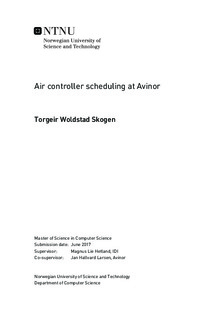Air controller scheduling at Avinor
Master thesis
Permanent lenke
http://hdl.handle.net/11250/2453246Utgivelsesdato
2017Metadata
Vis full innførselSamlinger
Sammendrag
The air space in Norway is controller by Avinor. This work is done by air traffic controllers, who operate under strict rules regarding how this work is carried out. This has implications on how long they can work and how many breaks they need.
In this paper, I present problems related the planning of this work, as well as a proposed algorithm for each one. The first of this is scheduling shifts for one day to meet the given demands, which indicate how many controllers are required to be working at each time. The second problem is to assign sectors of air space to shifts, such that the air space is covered. How sectors are assigned changes similarly to demands, and ideally, controllers work in stable combinations of sectors. Lastly, the given demands are forecasts, and to have an appropriate schedule when the demands are different from expected, the schedule usually use upper estimates for demands. In cases where the demands are lower, it is desired to have a plan for which controllers should get breaks.
The first two of these problems are solved using branch and bound searches and the last one is solved using a greedy algorithm. For the first one, the complexity is high, so branch and bound does not seem to be an ideal solution strategy, while for the second one it seems much more promising. The greedy solution to the third problem has a short running time, but does not guarantee an optimal solution.
